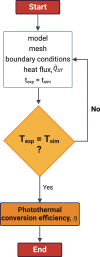Numerical Simulation of Light to Heat Conversion by Plasmonic Nanoheaters
- PMID: 39701587
- PMCID: PMC11719628
- DOI: 10.1021/acs.nanolett.4c04872
Numerical Simulation of Light to Heat Conversion by Plasmonic Nanoheaters
Abstract
Plasmonic nanoparticles are widely recognized as photothermal conversion agents, i.e., nanotransducers or nanoheaters. Translation of these materials into practical applications requires quantitative analyses of their photothermal conversion efficiencies (η). However, the value of η obtained for different materials is dramatically influenced by the experimental setup and method of calculation. Here, we evaluate the most common methods for estimating η (Roper's and Wang's) and compare these with numerical estimates using the simulation software ANSYS. Experiments were performed with colloidal gold nanorod solutions suspended in a hanging droplet irradiated by an 808 nm diode laser and monitored by a thermal camera. The ANSYS simulations accounted for both heating and evaporation, providing η values consistent with the Wang method but higher than the Roper approach. This study details methods for estimating the photothermal efficiency and finds ANSYS to be a robust tool where experimental constraints complicate traditional methods.
Keywords: Roper method; Wang method; gold nanorods; hanging droplet; photothermal conversion efficiency; simulation.
Conflict of interest statement
The authors declare no competing financial interest.
Figures





Similar articles
-
Near infrared photothermal inactivation of Candida albicans assisted by plasmonic nanorods.Photodiagnosis Photodyn Ther. 2024 Oct;49:104309. doi: 10.1016/j.pdpdt.2024.104309. Epub 2024 Aug 21. Photodiagnosis Photodyn Ther. 2024. PMID: 39154922
-
Tailoring Plasmonic Nanoheaters Size for Enhanced Theranostic Agent Performance.Bioengineering (Basel). 2024 Sep 18;11(9):934. doi: 10.3390/bioengineering11090934. Bioengineering (Basel). 2024. PMID: 39329676 Free PMC article.
-
Selecting High-Performance Gold Nanorods for Photothermal Conversion.Nanomaterials (Basel). 2022 Nov 25;12(23):4188. doi: 10.3390/nano12234188. Nanomaterials (Basel). 2022. PMID: 36500811 Free PMC article.
-
Strategies to improve the photothermal capacity of gold-based nanomedicines.Acta Biomater. 2020 Oct 15;116:105-137. doi: 10.1016/j.actbio.2020.09.008. Epub 2020 Sep 7. Acta Biomater. 2020. PMID: 32911109 Review.
-
Gold Nanorod-Assisted Photothermal Therapy and Improvement Strategies.Bioengineering (Basel). 2022 May 5;9(5):200. doi: 10.3390/bioengineering9050200. Bioengineering (Basel). 2022. PMID: 35621478 Free PMC article. Review.
Cited by
-
Differential evolution-optimized gold nanorods for enhanced photothermal conversion.Sci Rep. 2025 Mar 19;15(1):9543. doi: 10.1038/s41598-025-92007-7. Sci Rep. 2025. PMID: 40108225 Free PMC article.
References
-
- Karan N. S.; Keller A. M.; Sampat S.; Roslyak O.; Arefin A.; Hanson C. J.; Casson J. L.; Desireddy A.; Ghosh Y.; Piryatinski A.; et al. Plasmonic giant quantum dots: hybrid nanostructures for truly simultaneous optical imaging, photothermal effect and thermometry. Chem. Sci. 2015, 6 (4), 2224–2236. 10.1039/C5SC00020C. - DOI - PMC - PubMed
-
- Zaccagnini F.; Radomski P.; Sforza M. L.; Ziółkowski P.; Lim S.-I.; Jeong K.-U.; Mikielewicz D.; Godman N. P.; Evans D. R.; Slagle J. E.; et al. White light thermoplasmonic activated gold nanorod arrays enable the photo-thermal disinfection of medical tools from bacterial contamination. J. Mater. Chem. B 2023, 11 (29), 6823–6836. 10.1039/D3TB00865G. - DOI - PubMed
LinkOut - more resources
Full Text Sources

